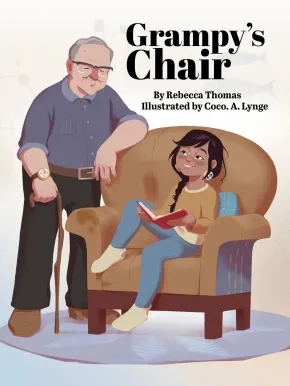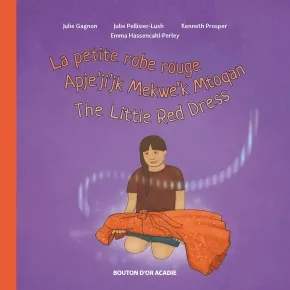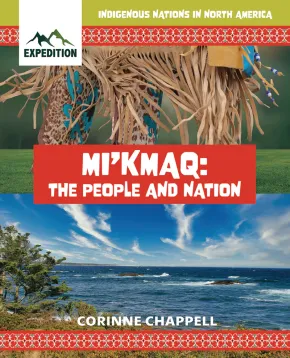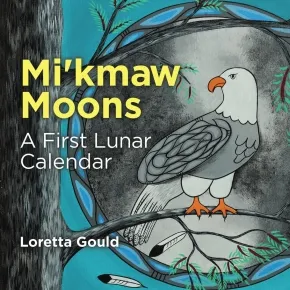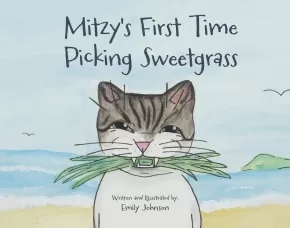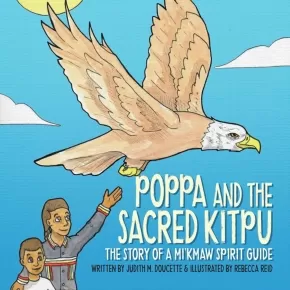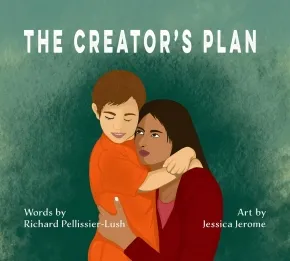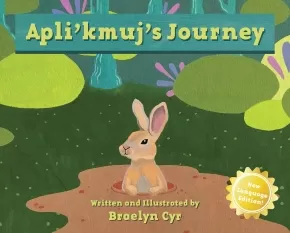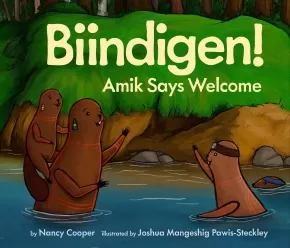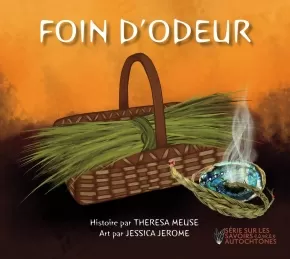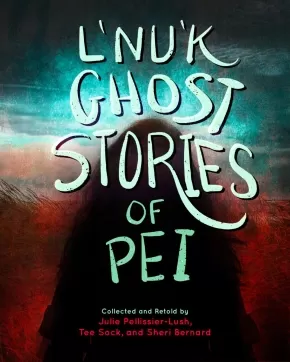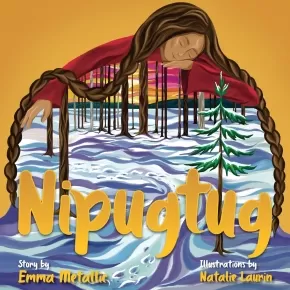
Mi'kmaq (Mi'gmaq)
31
-
45
of
78 Results;
Sort By
Go To
of 6
Grampy's Chair
$23.99
Artists:
Format:
Hardcover
Text Content Territories:
Indigenous Canadian; First Nations; Mi'kmaq;
ISBN / Barcode: 9781773219189
Synopsis:
Synopsis:
A heartwarming story about lifelong love and loss told from the perspective of a grandfather’s favorite chair.
Grampy’s chair sits in the middle of his living room and always keeps an eye on My Love. The Chair is the perfect spot for My Love to learn to read, to play games with her friends, and The Chair is always extra soft when My Love is sick. As My Love grows up, The Chair sees Grampy grow older and My Love must care for him. One day Grampy is gone, and The Chair is moved to a space with only a few things it recognizes (and a few spiders too). Will it see My Love again?
In this poignant story inspired by her own grandfather and his chair, Rebecca Thomas invites readers of all ages to explore love, grief, and the important moments in life that take place in our favorite spots. With lively illustrations from Coco A. Lynge and featuring a heartfelt author’s note, Grampy's Chair takes the readers through loss, and how we can be found again by the ones we love.
Educator Information
Recommended for ages 4 to 7.
Additional Information
36 pages | 7.65" x 10.25" | Hardcover
Indiginerds: Tales from Modern Indigenous Life
$30.50
Artists:
Format:
Paperback
Text Content Territories:
Indigenous Canadian;
ISBN / Barcode: 9781638991335
Synopsis:
Synopsis:
First Nations culture is living, vibrant, and evolving, and generations of Indigenous kids have grown up with pop culture creeping inexorably into our lives. From gaming to social media, pirate radio to garage bands, Star Trek to D&D, and missed connections at the pow wow, Indigenous culture is so much more than how it’s usually portrayed. Indiginerds is here to celebrate those stories!
Featuring an all-Indigenous creative team, Indiginerds is an exhilarating anthology collecting 11 stories about Indigenous people balancing traditional ways of knowing with modern pop culture. Includes work by Alina Pete, PJ Underwood, Kameron White, Rhael McGregory, and many more.
Educator Information
Recommended for ages 12 to 18.
Full Creator Listing: Tate Allen, Ida Aronson, Jordanna George, Raven John, Nipinet Landsem, Rhael McGregor, Sam “Mushki” Medlock, Alina Pete, Wren Rios, PJ Underwood, Kameron White
Additional Information
120 pages | 6.62" x 10.25" | Paperback
La petite robe rouge / Apje'ji'jk Mekwe'k Mtoqan / The Little Red Dress
$15.95
Format:
Paperback
Text Content Territories:
Indigenous Canadian; First Nations; Mi'kmaq;
ISBN / Barcode: 9782897503482
Synopsis:
Synopsis:
Sakari loves to rummage through her grandmother's house, but she doesn't know what's hidden in the woven basket her nukumi keeps in the attic. Then, one day, she sees her nukumi in tears by the open basket, holding a photo album with poems and photos that Sakari has never seen. This prompts the older woman to tell her the story of her younger sister who disappeared shortly after graduating high school. Sakari will help her nukumi to free herself from this heavy secret and allow the spirit of the missing young woman to fly away in peace.
This trilingual book, in English, French, and Mi'kmaq, is an excellent introduction to Red Dress Day, which aims to raise awareness for Missing and Murdered Indigenous Women and Girls.
Educator Information
The publisher recommends this book as an all-ages picture book.
Trilingual: French, Mi'kmaq, and English
Additional Information
32 pages | 8.50" x 8.50" | Paperback
Mi'kmaq: The People and Nation
$16.95
Format:
Paperback
Text Content Territories:
Indigenous Canadian; First Nations; Mi'kmaq (Mi'gmaq);
ISBN / Barcode: 9781774567708
Synopsis:
Synopsis:
The Mi'kmaq have many practices in their culture which make them unique. Discover more about the people and nation through Mi'kmaq author Corinne Chappell.
Educator & Series Information
This book is part of the Indigenous Nations in North America series.
Additional Information
32 Pages | Paperback
Mi'kmaw Moons: A First Lunar Calendar (BB)
$16.95
Artists:
Format:
Board Book
Text Content Territories:
Indigenous Canadian; First Nations; Mi'kmaq;
Grade Levels: Preschool; Kindergarten;
ISBN / Barcode: 9781459507456
Synopsis:
Synopsis:
This board book presents the months of the Mi’kmaw lunar calendar to very young children and their parents. Mi’kmaw artist Loretta Gould’s art illustrates each of the 12 Mi’kmaw moons through the changing seasons in Mi’kma’ki. Each month is named after events in the natural world – from Snow Blinding Time through Frogs Croaking Time and Berry Ripening Time. Each month’s illustration is accompanied by its name in Mi’kmaw and English.
Loretta Gould’s art, first published in Mi’kmaw Moons: A First Lunar Calendar has won high praise from reviewers, and the book has received numerous awards.
Educator Information
For ages 2 to 5.
Includes names of the months in English and Mi'kmaw.
This is the board book version of Mi'kmaw Moons: The Seasons in Mi'kma'ki.
Additional Information
6.53" x 6.53" | Board Book
Mitzy's First Time Picking Sweetgrass
$14.95
Artists:
Format:
Paperback
Text Content Territories:
Indigenous Canadian;
ISBN / Barcode: 9781777854287
Synopsis:
Synopsis:
This book is about a curious kitty who gets to experience her first time sweetgrass picking with her mom.
Educator Information
Recommended for ages 4 to 6.
Additional Information
28 pages | 9.25" x 7.28" | Paperback
Poppa and the Sacred Kitpu
$18.95
Artists:
Format:
Paperback
Text Content Territories:
Indigenous Canadian; First Nations; Mi'kmaq;
ISBN / Barcode: 9781774571859
Synopsis:
Synopsis:
After being invited into his grandson’s school to share his wisdom and knowledge of his traditional Mi’kmaw culture in Poppa and His Drum, Poppa is happy to return as a respected Indigenous Elder and Knowledge Keeper.
In this second book of the Poppa series, we find Poppa giving his next gin’masuti (lesson in our culture) to his grandson, François, and his friends, Paul and Joe.
The boys have an important art project to complete for school and are not sure what to do. While spending the afternoon on a beach adventure with Poppa, the boys get to learn about the Sacred Kitpu (Bald Eagle) and why it’s so important to our Indigenous People.
Poppa engages the children with eager imaginations of how the Sacred Kitpu is not only a powerful spirit guide, but also represents the Spirit of the Creator among us. It is the messenger between Mother Earth and the Spirit World, whispering to the Creator our prayers, touching the face of the Creator with its wing.
Poppa teaches the children through mystic wonder how we use the Sacred Kitpu feather in many different cultural ceremonies. He embraces their eagerness to learn and shares the tradition of smudging, using the Kitpu feather along with Sacred Medicines that burn in a smudge bowl to purify our body, mind, and spirit.
The children delight in discovering Poppa’s never-spoken-of regalia treasures that once belonged to his grandfather and decide to commemorate their art project to the Sacred Kitpu.
Poppa is invited back to the class to award the winning medal to the winners of the arts project. He is proud to present the medals to happy children who truly understand and appreciate the importance of the role the Sacred Kitpu plays in our Mi’kmaw culture and heritage. Poppa and the Sacred Kitpu will delight and surprise the reader with fun and teachings given by the love of a Poppa who is cherished by his community for being such a wonderful Mi’kmaw Elder.
Educator & Series Information
Recommended for ages 5 to 12.
This book is the second book in the Poppa series, following Poppa and His Drum.
Additional Information
9.00" x 9.00" | Paperback
The Creator's Plan
$14.95
Artists:
Format:
Paperback
Text Content Territories:
Indigenous Canadian; First Nations; Mi'kmaq (Mi'gmaq); Lennox Island First Nation;
ISBN / Barcode: 9781773661704
Synopsis:
Synopsis:
"My son, you do not need black hair, brown skin, or brown eyes like me to pray and practice your culture. You will learn the songs and the drumming in time. The Creator's plan was to give you everything that makes you who you are, and you are perfect to me just the way you are! Always remember that, no matter what anyone else says to you. We need to pray for those children too, my son, as hard as that may seem. But remember, you are exactly how the Creator planned you to be, and I will love you until the end of time."
As a Mi'kmaq child, Richard Pellissier-Lush grew looking different than other the other Indigenous children. He didn't feel he fit in with the non-Indigenous or the Indigenous children he knew. But his mother continually reminding him that he was part of the Creator's plan empowered him to embrace his culture no matter what he looked like. Her chorus of encouragement stayed with him through his childhood and helped make him the man he is today.
Educator Information
Recommended for ages 4 to 7.
Additional Information
32 pages | 9.00" x 9.00" | Paperback
Walking Together (PB)
$12.99
Format:
Paperback
Text Content Territories:
Indigenous Canadian; First Nations; Mi'kmaq;
ISBN / Barcode: 9781773217772
Synopsis:
Synopsis:
This bestselling, innovative picture book introduces readers to the concept of Etuaptmumk—or Two-Eyed Seeing, the gift of multiple perspectives in the Mi’kmaw language—as we follow a group of young children connecting to nature as their teacher.
A poetic, joyful celebration of the Lands and Waters as spring unfolds: we watch for Robin's return, listen for Frog's croaking, and wonder at maple tree's gift of sap. Grounded in Etuaptmumk, also known as Two-Eyed Seeing—which braids together the strengths of Indigenous and non-Indigenous ways of knowing—and the Mi’kmaq concept of Netukulimk—meaning to protect Mother Earth for the ancestors, present, and future generations—Walking Together nurtures respectful, reciprocal, responsible relationships with the Land and Water, plant-life, animals and other-than-human beings for the benefit of all.
Reviews
"Walking Together is a poetic celebration grounded in Etuaptmumk (Two-Eyed Seeing) that weaves together the strengths of Indigenous and non-Indigenous ways of knowing. The story explores respectful, reciprocal, responsible relationships between the land, water, plants, animals, and humans." - The Dalai Lama Center
Educator Information
Recommended for ages 4 to 7.
Introduces the concept of Two-Eyed Seeing (the gift of multiple perspectives) to young readers.
This book is available in a bilingual format: Walking Together / Menaqaj Pemwije’tulti’k
Additional Information
36 pages | 8.90" x 8.90" | Paperback
Amazing L’nu’k: A Celebration of the People of Mi'kma'ki
$24.95
Artists:
Format:
Paperback
Text Content Territories:
Indigenous Canadian; First Nations; Mi'kmaq;
ISBN / Barcode: 9781774711682
Synopsis:
Synopsis:
Delve into the uplifting stories of the people of Mi'kma'ki in this full-colour illustrated book. Meet a devoted water protector, learn about a teen determined to shed light on the tragic history of Residential Schools, and discover poets who use words to explore and champion the rich Mi'kmaw culture. From Grand Chief Gabriele Sylliboy and Elder Dorene Bernard to Rebecca Thomas and Landyn Toney, all of these amazing people call Mi'kma'ki (a territory that includes New Brunswick, Prince Edward Island, Nova Scotia, and parts of Newfoundland, Quebec, and Maine) home.
With dozens of profiles featuring artists, athletes, entrepreneurs, scientists, and more — both historical and present-day, from kids to Elders — Julie Pellissier-Lush and Robin Grant celebrate the many brilliant achievements of the Mi'kmaq.
Includes original colour illustrations by James Bentley, informative sidebars, a map of Mi'kmaw territories, a history of Mi'kma'ki , an index, and a glossary.
Educator Information
Recommended for ages 8 to 12
Additional Information
184 pages | 7.00" x 9.00" | Paperback
Apli'kmuj's Journey
$12.95
Artists:
Format:
Paperback
Text Content Territories:
Indigenous Canadian; First Nations; Mi'kmaq;
ISBN / Barcode: 9781777854270
Synopsis:
Synopsis:
Apli’kmuj, the rabbit, is heading to the gathering—all on his own! His forest friends try to help guide his way, but they must follow their own paths and cannot travel with him. The salmon swims upstream and the owl can fly above the trees, but how will Ali'kmuj get there to perform his dance for all the creatures at the gathering? Maybe the four sacred medicines can help him on his journey!
Apli’kmuj's Journey is a fun and accessible story that describes Mi'kmaq values and vocabulary, and was created to engage Indigenous and non-Indigenous children alike!
Educator Information
Recommended for ages 5 to 8.
This book teaches about the four sacred medicines, sweetgrass, sage, cedar, and tobacco.
Additional Information
36 pages | 10.03" x 8.07" | Paperback
Biindigen! Amik Says Welcome
$21.95
Format:
Hardcover
Text Content Territories:
Indigenous Canadian; First Nations; Anishinaabeg; Algonquin; Cree (Nehiyawak); Haudenosaunee (Iroquois); Kanyen'keha:ka (Mohawk); Mi'kmaq; Salish; Coast Salish; Inuit;
ISBN / Barcode: 9781771475150
Synopsis:
Synopsis:
Busy beavers have a family reunion in this story that celebrates Indigenous perspectives.
It’s a special day for Amik the beaver and her little sister, Nishiime. Their cousins are coming to visit! Amik is excited, but Nishiime feels nervous about meeting new people, and when the cousins finally arrive, Nishiime disappears.
Lively, immersive illustrations show Amik and her cousins as they search the woods for Nishiime. Each creature they encounter, introduced to readers using their Anishinaabe names, reveals how beavers help the forest community. A fish thanks them for digging canals in the mud that they swim through. A deer thanks the beavers for cutting down trees so they can reach the tastiest leaves. None of the creatures have seen Nishiime, but keen-eyed kids will have spotted her hiding in the background throughout the story.
Eventually, Nishiime returns to the group, having overcome her shyness by learning an important lesson: despite being from different places, the beavers are all united by the ways they support the forest ecosystem. With the perfect blend of fact and fun, this salute to the industrious beaver is also an energetic celebration of Indigenous perspectives, languages, and diversity.
Educator Information
Recommended for ages 3 to 7.
Includes some Anishinaabe words. A glossary is found at the back of the book.
Each beaver in the story comes from a different Nation, and their names mean "beaver" in their own language.
Curriculum Connections
Language Arts: Reading
Science: Needs and Characteristics of Living Things; Habitats
Social Studies: Indigenous Peoples
Additional Information
32 pages | 10.50" x 9.00" | Hardcover
Foin d'odeur
$13.95
Artists:
Format:
Paperback
Text Content Territories:
Indigenous Canadian; First Nations; Mi'kmaq;
ISBN / Barcode: 9781774711989
Synopsis:
Synopsis:
C'est le début du mois de juillet, et pour Matthew et sa tantine, cela signifie une chose : c'est le temps de la cueillette de foin d'odeur. Cette année, le jeune cousin de Matthew, Warren, y va aussi, et ce sera la première fois qu'il se rend au littoral où pousse le foin d'odeur. Grâce aux savoirs mi'kmaw traditionnels de Tantine et aux doux conseils de Matthew, Warren découvre la variété d'utilisations du foin d'odeur — comme médecine traditionnelle, offrande sacrée, ingrédient de purification par la fumée — ainsi que l?importance de ne pas cueillir plus que nécessaire pour ses besoins. Une fois le trio de retour chez Tantine, elle montre aux garçons comment nettoyer et tresser le foin. Cette histoire touchante sur les cadeaux que nous recevons de la Terre Mère et comment les cueillir avec respect offre une perspective réfléchie sur une tradition autochtone vénérée.
Educator Information
Recommended for ages 4 to 7.
This book is available in English: Sweetgrass
Additional Information
32 pages | 9.00" x 8.00" | Paperback
L'Nu'k Ghost Stories of Prince Edward Island
$19.95
Format:
Paperback
Text Content Territories:
Indigenous Canadian; First Nations; Mi'kmaq;
Reading Level: Juvenile Fiction
ISBN / Barcode: 9781773661292
Synopsis:
Synopsis:
Mi'kmaq people have been in touch with the spiritual for thousands of years. Some of these spiritual bonds have meant that the Mi'kmaq have resulted in scary encounters with the living. Ancients stories of ghosts and shape-shifters have been told around the fire for generations. Keeping this tradition alive is important not only for future campfires, but also to protect the sacred sites and hollowed grounds.
Educator Information
Juvenile Fiction
Additional Information
180 pages | 5.75" x 8.75" | Paperback
Nipugtug
$18.00
Artists:
Format:
Paperback
Text Content Territories:
Indigenous Canadian; First Nations; Mi'kmaq; Listuguj Mi'gmaq First Nation;
ISBN / Barcode: 9781928120414
Synopsis:
Synopsis:
Set in the community of Listuguj, Gespe'gewa'gi, Nipugtug follows the journey of A'le's (Mi'gmaw for Alice), a young Mi'gmaw woman, snowshoeing through the forest. There, she meets animals, Wapus (Rabbit), Wowgwis (Fox), Tia'm (Moose), Ga'qaquj (Crow) and trees, Masgwi (Birch), Qasgusi (Cedar) who guide her through both challenging and nourishing emotions of learning her Mi'gmaw language. Grounded in her relationship with the territory, A'le's navigates memories of her language that cling to realities within and beyond her life.
Educator Information
Recommended for ages 7 to 11.
Additional Information
21 pages | 9.00" x 9.00" | 4 Illustrations | Paperback
Sort By
Go To
of 6

